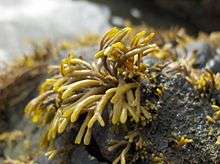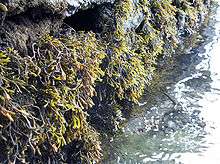Pelvetia
| Pelvetia canaliculata | |
|---|---|
 | |
| Close-up | |
 | |
| Growing on the side of a slipway | |
| Scientific classification | |
| (unranked): | SAR |
| Superphylum: | Heterokonta |
| Class: | Phaeophyta |
| Order: | Fucales |
| Family: | Fucaceae |
| Genus: | Pelvetia Decne. & Thur. |
| Species: | P. canaliculata |
| Binomial name | |
| Pelvetia canaliculata (L.) Decne. & Thur. | |
| Synonyms [1] | |
| |
Pelvetia canaliculata, channelled wrack, is a very common brown alga (Phaeophyceae) found on the rocks of the upper shores of Europe. It is the only species remaining in the monotypic genus Pelvetia.[1][2] In 1999, the other members of this genus were reclassified as Silvetia due to differences of oogonium structure and of nucleic acid sequences of the rDNA.[3]
Description
Pelvetia grows to a maximum length of 15 centimetres (6 in) in dense tufts, the fronds being deeply channelled on one side: the channels and a mucus layer help prevent the seaweed drying (desiccation) when the tide is out. It is irregularly dichotomously branched[4] with terminal receptacles,[5] and is dark brown in colour. Each branch is of uniform width and without a midrib. The receptacles are forked at the tips.
It is distinguished from other large brown algae by the channels along the frond. It has no mid-rib, no air-vesicules and no cryptostomata. It forms the uppermost zone of algae on the shore growing at or above high-water mark.[6] The reproductive organs form swollen, irregularly shaped receptacles at the end of the branches. The conceptacles are hermaphrodite and borne within the receptacles.
Ecology
Pelvetia canaliculata is the only large algae growing on rocks forming a zone along the upper shore at the upper littoral zone, on the shores of the British Isles. It tolerates a wide range of exposure conditions.[7] It needs periods of exposure to the air, and sometimes grows so high up a beach that coarse grass and other longshore angiosperms grow among it. If it is submerged for more than six hours out of 12 it begins to decay.[8]
Distribution
Pelvetia canaliculata is common on the Atlantic shores of Europe from Iceland to Spain, including Norway, Ireland, Great Britain, the Netherlands, France and Portugal.[9] In Ireland, collection of Pelvetia canaliculata (Irish: dúlamán) has been recorded as a source of sustenance during times of famine.[10] A popular Irish folk song, Dúlamán, describes events transpiring between two people who collected the seaweed as a profession.
References
- 1 2 M. D. Guiry & G. M. Guiry. "Genus: Pelvetia". AlgaeBase. National University of Ireland, Galway. Retrieved April 24, 2012.
- ↑ Fernando G. Cánovas, Catarina F. Mota, Ester A. Serrão & Gareth A. Pearson (2011). "Driving south: a multi-gene phylogeny of the brown algal family Fucaceae reveals relationships and recent drivers of a marine radiation". BMC Evolutionary Biology. 11: 371. doi:10.1186/1471-2148-11-371. PMC 3292578
 . PMID 22188734.
. PMID 22188734. - ↑ Ester A. Serrão, Lawrence A. Alice & Susan H. Brawley (1999). "Evolution of the Fucaceae (Phaeophyceae) inferred from nrDNA-ITS" (PDF). Journal of Phycology. 35: 382–394. doi:10.1046/j.1529-8817.1999.3520382.x.
- ↑ W. E. Jones (1962). "A key to the genera of British seaweeds". Field Studies. 1 (4): 1–32.
- ↑ L. Newton (1931). A Handbook of the British Seaweeds. British Museum, London.
- ↑ C. I. Dickinson (1963). British Seaweeds. The Kew Series.
- ↑ J. R. Lewis (1964). The Ecology of the Rocky Shores. The English Universities Press Ltd. London.
- ↑ D. Thomas (2002). Seaweeds. Life Series. London: Natural History Museum. ISBN 0-565-09175-1.
- ↑ M. D. Guiry & Wendy Guiry (October 25, 2006). "Pelvetia canaliculata (Linnaeus) Decaisne & Thuret". AlgaeBase.
- ↑ Doreen McBride (1994). "When Hunger Stalked the North".
External links
| External identifiers for Pelvetia canaliculata | |
|---|---|
| Encyclopedia of Life | 893103 |
| ITIS | 11347 |
| NCBI | 48071 |
| WoRMS | 144130 |
| Also found in: Wikispecies | |
 Media related to Pelvetia canaliculata at Wikimedia Commons
Media related to Pelvetia canaliculata at Wikimedia Commons- N. White (2006). "Channelled wrack, Pelvetia canaliculata". Marine Life Information Network for Britain and Ireland. Plymouth: Marine Biological Association of the United Kingdom.
- David W. Connor, James H. Allen, Neil Golding, Kerry L. Howell, Louise M. Lieberknecht, Kate O. Northern & Johnny B. Reker (2004). "LR.LLR.F.Pel: Pelvetia canaliculata on sheltered littoral fringe rock". The Marine Habitat Classification for Britain and Ireland Version 04.05. JNCC, Peterborough. ISBN 1-861-07561-8.